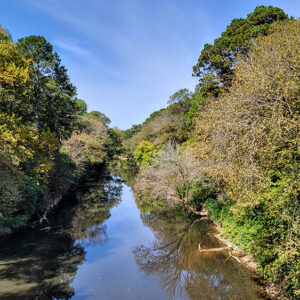calsfoundation@cals.org
Antoine River
The Antoine River rises from a confluence of streams in the Ouachita Mountains of Pike County, just west of Amity (Clark County). From there, it flows southeast, forming part of the boundary between Pike and Clark counties, until it empties into the Little Missouri River near the town of Okolona (Clark County). Some sources call the waterway Antoine Creek. It is one of the shorter rivers in Arkansas, with a total length of thirty-five miles, all of which lie within the state.
The area along the river has been the site of human habitation since approximately 10,000 BC. During the historic period, the Caddo Indians controlled this region of southwest Arkansas. French explorers and trappers likely gave the river its name—“Antoine” is a common French masculine name. The town of Antoine (Pike County) likely takes its name from the river, though some sources have the town named after a man known only by that name.
There was apparently a bridge over the Antoine River by 1836. Though some early white settlers did grow cotton and other crops on the lower reaches of the river, the river never provided a major transportation corridor, and the area around the river remained rather sparsely settled until the arrival of the timber industry and the railroad in the late nineteenth and early twentieth centuries. The Missouri Pacific worked on building their railroad along the west side of the river until 1905, when a rock slide that killed nine workers led the company to rebuild the route along the east side. This line paralleled much of the river until it reached Pike Junction (Clark County).
In 1907, the Arkadelphia Lumber Company moved to a site near the Antoine River; this eventually became the town of Graysonia (Clark County), which for several years was home to one of the largest mills in the South. However, the “cut and run” practices of the lumber companies that operated along the river soon led to the decline of Graysonia and other mill towns.
Unlike other waterways in this region of Arkansas—such as the Cossatot, Little Missouri, Caddo, and Ouachita rivers—the Antoine River has not been dammed. This is likely because impounding the short river would not provide much flood control. Though the river is not as popular among canoeists as others in the region, it is well known for bluegill, catfish, crappie, and bass fishing.
For additional information:
Early History of Pike County, Arkansas: The First Hundred Years. Murfreesboro, AR: Pike County Archives and History Society, 1989.
Richter, Wendy, ed. Clark County, Arkansas: Past and Present. Arkadelphia, AR: Clark County Historical Association, 1992.
Staff of the CALS Encyclopedia of Arkansas
 Antoine River
Antoine River  Antoine River Bridge
Antoine River Bridge 




Comments
No comments on this entry yet.